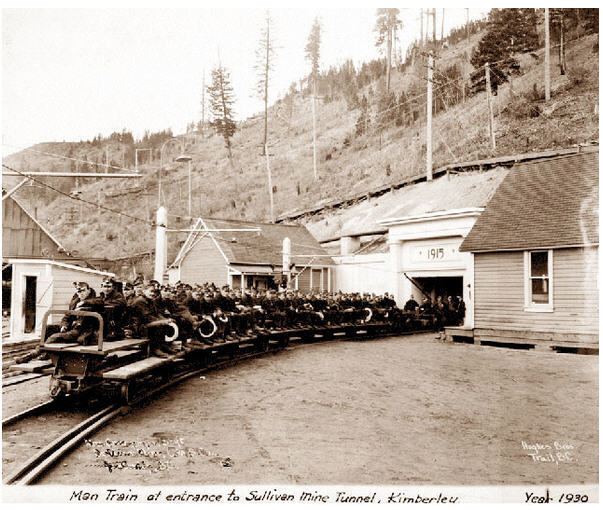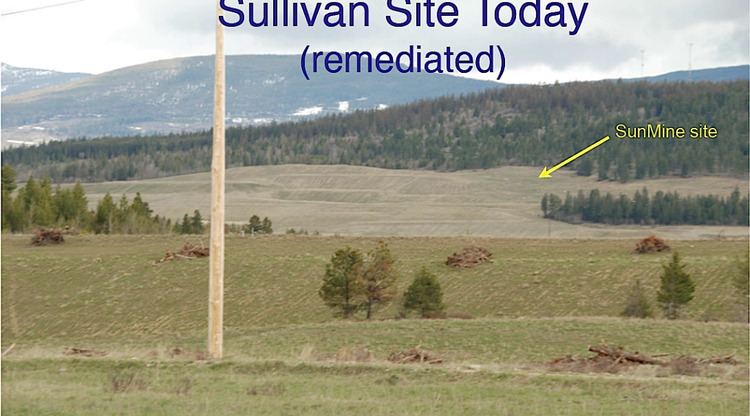 | ||
The station at the sullivan mine
The Sullivan Mine was an underground conventional–mechanized mine located in Kimberley, British Columbia, Canada; it has a complex, sediment-hosted orebody, made up primarily of zinc, lead, and iron sulphides. Lead, zinc, silver and tin were the economic metals produced.
Contents
- The station at the sullivan mine
- Building a future for sullivan mine
- Conventional mining
- Mechanized mining
- Exploration
- Decommissioned mine accident
- References

The deposit was discovered in 1892 and acquired in 1909 by the CPR-owned Consolidated Mining and Smelting Company of Canada (later Cominco Ltd. and Teck Cominco). The mine's economic success resulted largely from Sullivan's 1916 development of the differential flotation process that allowed separate recovery of lead and zinc concentrates in the milling process. This technology, developed by Trail operations at Sullivan, has been used worldwide for various types of ore bodies. In its lifetime, the mine produced ore containing over 17 million tons of zinc and lead and more than 285 million troy ounces (8.9×109 g) of silver, which were together worth more than $20 billion. After 92 years of active production, the Sullivan Mine was closed in 2001. Since then Teck Cominco has been undertaking an extensive decommissioning and reclamation process at the site.

Building a future for sullivan mine
Conventional mining

Conventional mining referred to the original part of operations of the Sullivan Mine, where miners drilled and moved ore by hand and with small equipment. The ore was then shipped via an extensive 3 ft (914 mm) narrow gauge underground rail system which led to the surface and then on to the Marysville concentrator. At one time there were more than 5,600 feet (1,700 m) of rail underground. Conventional tunnels were standard 8 by 8 ft (2.438 by 2.438 m) square. There was also a rail man-carrier that brought men in and out of the mine, descending on a sled full of chairs at a 60 degree bank. The railway system went everywhere underground, and ore was sent by rail to crushing chambers. The Sullivan mine had three such chambers where ore was initially crushed in order to begin to process it into its separate components, and debris was separated from the crushed ore. These impressive chambers were belt driven and had well-lit stations where men would monitor and maintain the process and machinery. There were two main crushers, and the third was smaller. Much of the railroad track and equipment is now used at the nearby Kimberley's Underground Mining Railway attraction.
Many accidents causing injury and death occurred on the conventional side. "Hot Muck", a rare occurrence of ore with high concentrations of sulfur, would glow red and white and release amazing amounts of heat and gas when exposed to air. Miners at that time had to wear special protective suits while they processed this ore.
Mechanized mining
Mechanized mining refers to using heavy equipment to speed up the mining process. The first attempt at a mechanized 10 by 10 ft (3.05 by 3.05 m) tunnel was around 1975. Referred to as '4250' (level) was collared and connected to the conventional rail drift in 1976. Much of the area was widened, tracks taken out, and a junction was created at 3900 level with three separate tunnels. One tunnel went to a massive repair facility '#7' and garage for servicing underground equipment. In 1979 #1 tunnel, which became the main tunnel, was collared and a new drift created at 4800 level to recover silver at the top of the mine. Heavy equipment including jumbos, various air or electric scoop trams in 2 to 8 yards (1.8 to 7.3 m) configurations, rockbolt jumbos, giraffes, shotcrete machines, hyabs, mancarriers, dozers, graders, and jeeps were used. Rockbreakers, downhole drills, fan drills, long hole drills, and TNT drills were some of the equipment used to drill for blasting tunnel faces. As the mining for ore pillars continued, most shops were moved above ground for safety.
There was a small open pit facility at the top of the mine that was used for the extraction of iron that was shipped to Vancouver. There was a Comico steel plant on site, right next to the fertilizer plant. It was in operation until the boiler blew and killed some workers there. It was decided to cease steel production and farm out that part of operations. The remnants of the Cominco steel plant were then destroyed.
With one exception, mechanized mining never mined in virgin territory. Conventional mining created huge pillars as miners extracted ore and left massive supports to hold up the ceilings of the drifts. Mechanized miners had the responsibility of removing such pillars, also full of ore, until none remained.
The exception to never mining in virgin territory came with the South East Fringe. 2600 level was the last of the original ore body recovered. After this, decommissioned equipment could be purchased by companies or for personal use and a two-year process of decommissioning the mine and making it as environmentally and structurally safe as possible began. The pumps and fans were turned off and the mine flooded. It was the end of a more-than-100-year era for a very special mining facility. Rarely is an ore body rich enough to support such a large operation for so many years. This mine was the primary employer for the residents of the City of Kimberley perched on top of all of these tunnels.
Exploration
As of December 2008, Abitibi Mining Corporation (ABB: TSXV) is exploring a large ore body along the Sullivan vein in the Nelson Mining District of the East Kootenay mountains. The company, with its partners, are currently drilling the Sullivan horizon and Sullivan sub-basin.
Exploration continues,
TECK Resources , the descendant of COMINCO,is still exploring for the "next" Sullivan mine. As of May/2016 TECK Resources has optioned and staked property and committed to spending up to $8,000,000. on exploration expenditures, on a highly prospective mineralized property on the Moyie Fault,a similar structure to the Kimberley Fault, where the Sullivan mine is located. The property is approximately 35 kilometers to the southeast of the Sullivan mine. See news release from PJX Resources, May 16/2016.
Decommissioned mine accident
On May 17, 2006, it was announced that four people died in an accident at the decommissioned mine. Douglas Erickson, a contractor who was doing routine water sampling, was overcome by lack of oxygen. Two days later, after being reported missing, he was found by Teck Cominco employee Robert Newcombe, who was able to dial 9-1-1 before also succumbing to the oxygen depleted atmosphere. The two paramedics that responded, Kim Weitzel and Shawn Currier, also died in the oxygen-deprived atmosphere of the shed. The bodies were recovered by firefighters equipped with breathing apparatus. It was not any kind of poisoning which the victims succumbed to, but suffocation in an environment completely devoid of oxygen, in an archetypal confined space accident.
